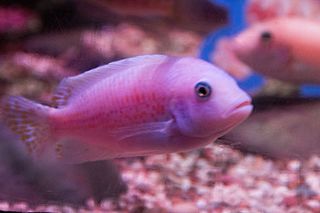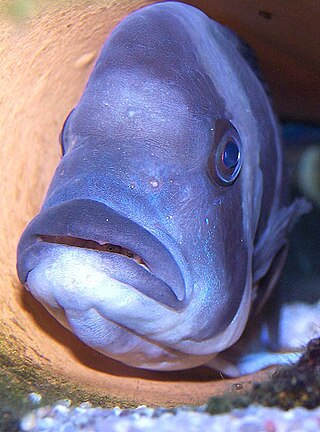
Cichlids are fish from the family Cichlidae in the order Cichliformes. Traditionally Cichlids were classed in a suborder, the Labroidei, along with the wrasses (Labridae), in the order Perciformes, but molecular studies have contradicted this grouping. On the basis of fossil evidence, it first appeared in Tanzania during the Eocene epoch, about 46–45 million years ago. The closest living relative of cichlids is probably the convict blenny, and both families are classified in the 5th edition of Fishes of the World as the two families in the Cichliformes, part of the subseries Ovalentaria. This family is large, diverse, and widely dispersed. At least 1,650 species have been scientifically described, making it one of the largest vertebrate families. New species are discovered annually, and many species remain undescribed. The actual number of species is therefore unknown, with estimates varying between 2,000 and 3,000.

Lake Malawi, also known as Lake Nyasa in Tanzania and Lago Niassa in Mozambique, is an African Great Lake and the southernmost lake in the East African Rift system, located between Malawi, Mozambique and Tanzania.

Mouthbrooding, also known as oral incubation and buccal incubation, is the care given by some groups of animals to their offspring by holding them in the mouth of the parent for extended periods of time. Although mouthbrooding is performed by a variety of different animals, such as the Darwin's frog, fish are by far the most diverse mouthbrooders. Mouthbrooding has evolved independently in several different families of fish.

Pseudotropheus is a genus of fishes in the family Cichlidae. These mbuna cichlids are endemic to Lake Malawi in Eastern Africa.

Alloparenting is a term used to classify any form of parental care provided by an individual towards young that are not its own direct offspring. These are often referred to as "non-descendant" young, even though grandchildren can be among them. Among humans, alloparenting is often performed by a child's grandparents and older siblings. Individuals providing this care are referred to using the neutral term of alloparent.

The terms shell dwellers or shelldwellers, shell-breeding, or ostracophil are descriptive terms for cichlid fish that use the empty shells of aquatic snails as sites for breeding and shelter. The terms have no taxonomic basis, although most shell-dwelling cichlids are from Lake Tanganyikas lamprologine lineage. Many shell dwelling cichlids are popular with fishkeepings and are frequently kept in aquaria.

Maylandia or Metriaclima is a genus of haplochromine cichlids endemic to Lake Malawi in East Africa. They belong to the mbuna (rock-dwelling) haplochromines.

Variabilichromis moorii has no common name and is a species of freshwater cichlid endemic to Lake Tanganyika in eastern Africa. It is a small ovate bodied fish named for an early collector of fish from the lake, John Edmund Sharrock Moore (1870-1947) who was a cytologist, zoologist and led an expedition to Lake Tanganyika and who discovered this species. Juveniles are usually yellow, and adults are dark brown to black in color. It reaches a total length (TL) of 10.3 centimetres (4.1 in). Currently it is the only member of its genus. V. moorii feeds on algae, zooplankton, and benthic invertebrates. It is also found in the aquarium trade.

Pseudotropheus crabro, the Bumblebee Cichlid or Hornet Cichlid, is a species of cichlid endemic to Lake Malawi where it is found in different habitats but most frequently in large caves or in the vicinity of large boulders. This species can reach a length of 16 centimetres (6.3 in) SL.

Synodontis multipunctatus, also known as the cuckoo catfish, cuckoo squeaker, or multipunk, is a small catfish from Lake Tanganyika, one of the lakes in the Great Rift Valley system in Africa. It is a brood parasite upon mouthbrooding cichlids. This species grows to a length of 27.5 centimetres (10.8 in) TL. This species is a minor component of local commercial fisheries.

Bagrus is a genus of bagrid catfishes. These are relatively large catfish found in freshwater habitats in Africa, except for the virtually unknown B. tucumanus from South America, which likely is a synonym of Luciopimelodus pati.

Paedophagy in its general form is the feeding behaviour of fish or other animals whose diet is partially, or primarily the eggs or larvae of other animals. However, P. H. Greenwood, who was the first to describe paedophagia, defines it to be a feeding behaviour evolved among cichlid fishes.

Pseudotropheus johannii or the bluegray mbuna is an African freshwater fish from the family Cichlidae.

The bayad, is a species of bagrid catfish from Africa.
Bathyclarias nyasensis is a species of airbreathing catfish endemic to Lake Malawi, in the countries of Malawi, Mozambique and Tanzania. This species grows to a length of 100 cm SL. This species is commercially caught for human consumption.
Copadichromis geertsi is a species of haplochromine cichlid which is endemic to Lake Malawi.
Ctenopharynx pictus is a species of fish in the family Cichlidae. It is restricted to Lake Malawi. It occurs throughout much of the lake, but mainly in rocky habitats at depths of 7–30 m (23–98 ft). It is a mouthbrooder, but the female will often release the young near nesting kampango catfish. Their young are then brought up together.

The zebra mbuna is a species of cichlid endemic to Lake Malawi in Africa. This species can reach a length of 11.3 cm (4.4 in). It feeds on aufwuchs, a surface layer of mostly algal material that grows on rocks. This cichlid is a mouthbrooder and the female broods the eggs in her mouth for about three weeks. This fish can sometimes be found in the aquarium trade.

Pseudotropheus saulosi is a species of cichlid endemic to Lake Malawi in East Africa, where it lives in areas with rocky substrates. It is classified as a dwarf-mbuna and was first described by Ad Konings in 1990, who gave it the specific name saulosi in honour of Saulos Mwale who caught over 3,000 specimens in a single day on the expedition which collected the type. It comes from an area of the lake called Taiwan Reef, and from nowhere else. This fish can also be found in the aquarium trade.

Trematocranus placodon is a species of cichlid fish endemic to Lake Malawi, Lake Malombe and the upper reaches of the Shire River in Africa. It is mainly a shallow-water species that prefers to occupy areas with patches of Vallisneria, but it can occur as deep as 31 m (102 ft). It can reach a total length of up to 25 cm (9.8 in).


















